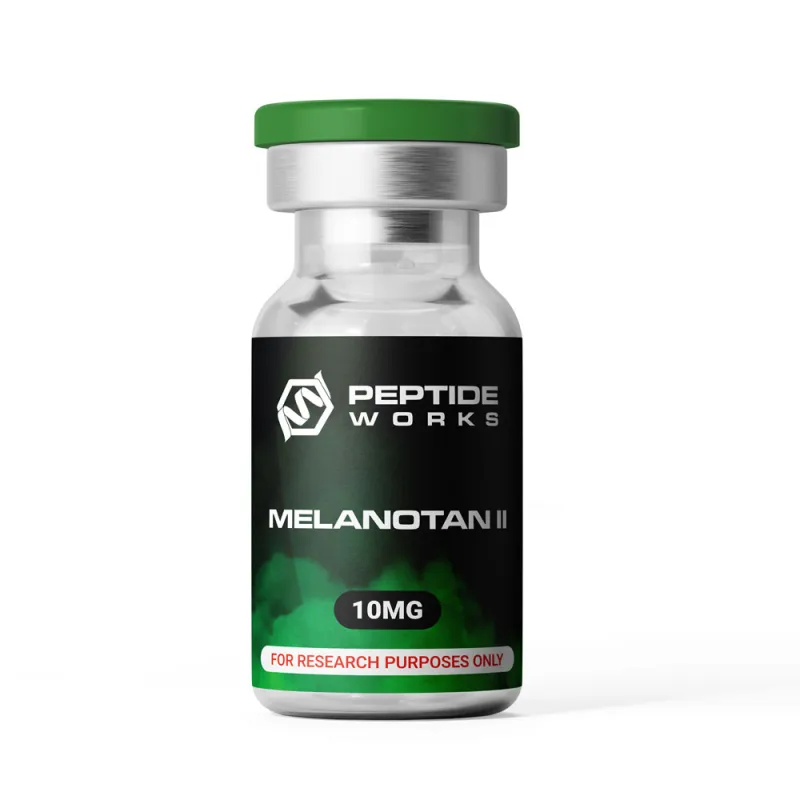
PROMO!
First order? Get 10% OFF with this code: 1storder

Melanotan 2 peptide is a synthetic analog of a natural hormone called alpha-melanocyte-stimulating hormone. Researchers have studied it for a wide range of biological effects. Early research focused on skin pigmentation. More recently, scientists have been asking a bigger question: might it influence the brain systems that govern emotion and behavior?
Oxytocin, known as the “bonding hormone,” helps control trust, social connections, and stress. Research suggests that Melanotan 2 peptide might affect the same pathways, indicating a possible link between peptide activity and emotional responses.
To understand this potential relationship, we first need to examine the mechanisms behind how Melanotan 2 peptide works within the body’s hormone systems.
Explore Melanotan 2 Peptide from Peptide Works, a synthetic analog that influences skin pigmentation, sexual function, and neuroendocrine pathways for research into behavior and stress response.

Melanotan 2 peptide binds to melanocortin receptors. These receptors help regulate appetite, sexual function, and stress response. When they’re activated, other hormones may be released or adjusted.
Oxytocin peptide appears to link into these pathways as well. While the exact mechanism is still being studied, evidence suggests overlap in brain signaling. That’s why Melanotan 2 is so interesting: it might influence how different hormone systems communicate with one another. Such effects highlight its potential role in broader neuroendocrine activity.
To see how this works in practice, it helps to look more closely at the receptors where Melanotan 2 attaches.
Discover Oxytocin Peptide from Peptide Works, the “bonding hormone” that helps regulate social behavior, trust, and stress responses for laboratory studies on emotion and social function.
Melanotan 2 peptide binds to four melanocortin receptors, MC1R, MC3R, MC4R, and MC5R, distributed throughout the brain and body. This binding raises cyclic-AMP inside the cell, a rapid signal that adjusts appetite cues, cortisol release, and reproductive rhythms.
MC4R clusters sit right beside oxytocin-producing neurons in the hypothalamus, while MC3R is also abundant there, though its role is less defined. A single Melanotan 2 pulse can ripple from melanocortin circuits into oxytocin pathways, linking metabolic and social hormone loops. Animal studies even report that activating MC4R with Melanotan 2 can boost central oxytocin.
The location of these receptors raises an important question: Does this proximity translate into direct influence on oxytocin release?

Studies have examined how Melanotan 2 peptide binds MC3R and MC4R in the hypothalamus near oxytocin neurons.When these receptors activate, intracellular cyclic-AMP rises, which may influence oxytocin release during certain social or stress-linked experiments.
Studies suggest these effects are context-dependent, rather than constant, which makes sense, given how hormone networks work in the brain. Researchers now compare oxytocin activity with melanocortin signals to map shared nodes inside wider neuroendocrine pathways.
Understanding this context-dependent activity becomes even more crucial when considering how it may translate into actual behavioral changes.
Melanotan 2 has been shown in animal studies to influence behavior, though results are mixed and highly dependent on model and context. It acts through brain regions that connect to oxytocin release. Some studies report improved stress control and mood when certain receptors are activated. These effects occur in the same brain areas where oxytocin neurons sit close to MC4R receptors.
Current research is exploring whether Melanotan 2 peptide could impact autism-related behaviors, social recognition, and stress relief. The effects, however, appear to depend heavily on dose and situation. This fits with the growing scientific interest in peptides as potential tools for brain and behavior research.
Because oxytocin plays a key role in social bonding, researchers are investigating whether Melanotan 2 might improve social behaviors affected by autism.

Animal studies suggest Melanotan 2 may help address social deficits linked with autism. Some findings report improved social contact and fewer repetitive behaviors when brain receptors tied to oxytocin release are activated.
The peptide works through MC4R receptors in regions of the brain that control bonding and social recognition. In effect, it seems to restore certain social functions that autism can disrupt. Again, outcomes depend on timing and dosage.
Researchers are now asking whether Melanotan 2 peptide could support social functioning in autism. This is part of a broader effort to study how peptide pathways might provide new approaches for brain and behavior research.
In preclinical work, melanocortin agonists can engage oxytocin circuitry within hours after central administration. Continuous infusion of Melanotan 2 peptide, on the other hand, has been shown to produce behavioral changes over several days in disease models.
The exact timeline varies by dose, delivery method, and duration of treatment. Sustained Melanotan 2 delivery has been linked with changes in stress response and social behavior. These timing effects mirror the activation of melanocortin receptors that connect with oxytocin release and social bonding.
At this stage, it’s worth noting: Peptide Works supplies high-quality peptides for authorized laboratory studies investigating these exact timing effects and pathways.
These timing insights pave the way for exploring Melanotan 2’s potential in wider neurobehavioral research.
Melanotan 2 peptide shows strong potential for influencing brain systems tied to social behavior through oxytocin pathways. By binding MC3R and MC4R receptors near oxytocin neurons, it has been linked to improved stress control, bonding, and even autism-related behaviors in research models.
Both Melanotan 2 and oxytocin peptide are being used as tools to better understand brain and social function. Timing and dosing are key, with effects appearing within hours to days of treatment.
Future studies may open doors to new therapeutic insights. At Peptide Works, we remain committed to supporting this progress by providing research-grade peptides for authorized scientific studies exploring these pathways.
All peptides supplied by Peptide Works, including Melanotan 2 and oxytocin, are strictly intended for laboratory research purposes only. They are not for human consumption, therapeutic use, or any form of self-administration.
[1] Paiva L, Sabatier N, Leng G, Ludwig M. Effect of Melanotan-II on Brain Fos Immunoreactivity and Oxytocin Neuronal Activity and Secretion in Rats. J Neuroendocrinol. 2017 Feb;29(2).
[2] Raposinho PD, White RB, Aubert ML. The melanocortin agonist Melanotan-II reduces the orexigenic and adipogenic effects of neuropeptide Y (NPY) but does not affect the NPY-driven suppressive effects on the gonadotropic and somatotropic axes in the male rat. J Neuroendocrinol. 2003 Feb;15(2):173-81.
[3] Yuan XC, Tao YX. Ligands for Melanocortin Receptors: Beyond Melanocyte-Stimulating Hormones and Adrenocorticotropin. Biomolecules. 2022 Oct 1;12(10):1407.
[4] Minakova E, Lang J, Medel-Matus JS, Gould GG, et al. Melanotan-II reverses autistic features in a maternal immune activation mouse model of autism. PLoS One. 2019 Jan 10;14(1):e0210389.
[5] Baribeau DA, Anagnostou E. Oxytocin and vasopressin: linking pituitary neuropeptides and their receptors to social neurocircuits. Front Neurosci. 2015 Sep 24;9:335.
ALL CONTENT AND PRODUCT INFORMATION AVAILABLE ON THIS WEBSITE IS FOR EDUCATIONAL PURPOSES ONLY.
DISCLAIMER: These products are intended solely as a research chemical only. This classification allows for their use only for research development and laboratory studies. The information available on our Peptide Works website: https://peptide-works.com/ is provided for educational purposes only. These products are not for human or animal use or consumption in any manner. Handling of these products should be limited to suitably qualified professionals. They are not to be classified as a drug, food, cosmetic, or medicinal product and must not be mislabelled or used as such.
Peptide Works
Related Articles

Could Orexin A peptide Treat Daytime Fatigue?
Waking up tired frustrates many people. Dragging through a full day with heavy eyes and slow focus makes work and

How can the Adamax Peptide help Chronic Inflammation?
Chronic inflammation acts like a fire that never stops burning. It slows recovery, drains energy, and blocks proper tissue repair.

Can Vitamin B12 Immune System Support Enhance the Effects of Thymosin Alpha-1?
The Vitamin B12 immune system link is important because this vitamin plays a crucial role in DNA synthesis, methylation, energy